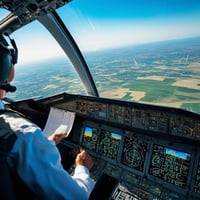Automation in Aviation: Are We Trusting Technology Too Much, Too Soon? The aviation industry has...
Automation’s Hidden Threat: Why Overreliance on Drones and Autonomy May Be Aviation’s Greatest Risk
Automation’s Hidden Threat: Why Overreliance on Drones and Autonomy May Be Aviation’s Greatest Risk
Aviation has always balanced risk with innovation. But as we rush into a future of drones, AI copilots, and self-flying aircraft, we risk forgetting one essential truth: technology fails, and when it does, it is the pilot who saves the day.
We are approaching a moment where humans may no longer be the last line of defense. That should alarm everyone who steps on an aircraft, lives under a flight path, or depends on air transport for business, medicine, and security.
The View From the Cockpit
No drone camera can match a pilot’s perspective. A pilot sees the weather building on the horizon, feels a subtle vibration that signals a mechanical problem, and spots conflicting traffic before ATC ever calls it out.
A remote operator sees only what the sensors show. A flat screen cannot replicate full situational awareness.
Drones are excellent tools for certain missions—pipeline inspection, disaster mapping, reconnaissance in dangerous areas—but they cannot replace a pilot in the loop. The view from the cockpit is more than a picture. It is a complete understanding of the environment.
Automation Fails Every Day
This is the part the public never sees. Automation is not perfect. It is a tool that fails somewhere, every day.
Autopilots disconnect without warning. RNAV systems fail to intercept courses. Flight directors give false commands. GPS signals drop offline.
When this happens, pilots keep the system safe. One flies the airplane while the other troubleshoots and runs checklists. They switch systems, recover navigation, and restore order.
This is invisible to most passengers, but it is what keeps the skies safe. If these same failures happened with no pilot present, the result would not be a smooth recovery. It would be a crash.
The FAA does not track these automation failures in a way the public can see. If people knew how often pilots have to intervene to save the day, they would think twice about fleets of autonomous cargo drones flying over neighborhoods, or armed military drones operating over U.S. soil.
Pilots do not just monitor automation. They actively manage it. They step in when it fails. That partnership is what makes the system resilient. Remove the pilot, and you remove the safety net.
Security: The Weakest Link
Even if automation were perfect, it still relies on something even more fragile: secure signals and communications.
Every control link can be jammed. Every GPS signal can be spoofed. Every network can be hacked.
We have already seen GPS jamming in conflict zones and spoofing incidents that forced airliners to divert. As aviation grows more connected, the attack surface expands.
Artificial intelligence will make attacks faster and more adaptive. Quantum computing will eventually break the cryptography that protects most communication links. Hostile actors are already harvesting encrypted data today so they can decrypt it later when the technology catches up.
This means the control systems for autonomous aircraft, which we assume are safe, may be open to exploitation in the near future. Without rapid adoption of post-quantum encryption and constant upgrades, entire fleets could be hijacked, grounded, or turned into weapons.
The Human Cost
Automation is also taking away critical training jobs.
Pipeline patrol, aerial survey, and agricultural flying have always been proving grounds for new pilots. They teach weather judgment, risk management, and real-world decision-making that cannot be learned in a simulator.
When drones take these jobs, we lose a generation of pilots who would have gone on to crew charter, corporate, and airline aircraft.
The military is experiencing the same problem. Reconnaissance squadrons are shrinking as unmanned fleets grow. Fewer pilots are logging tactical hours and gaining the experience they will need in the next major conflict.
Autonomy Must Remain a Tool
Automation and drones are powerful, but they must remain tools. They should assist pilots, not replace them.
Autonomy should reduce workload, extend reach, and provide data, but the final decisions must remain with trained humans.
When technology becomes the primary decision-maker, the system becomes brittle. The first major crash involving a fully autonomous aircraft will not be blamed on a pilot—it will be blamed on the absence of one.
A Smarter Future
If aviation is to stay safe, we must track automation failures just as we track engine failures. We must move quickly to secure communications against quantum-era attacks. We must protect hour-building jobs for new pilots to keep the pipeline strong. And we must require human oversight with the ability to intervene in all high-risk operations.
Technology should make pilots better, not make them disappear. If we fail to strike that balance, the biggest disaster in aviation history may not come from pilot error, but from a world that no longer had a pilot there to save it.



